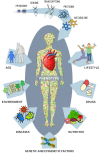Lipid Metabolite Biomarkers in Cardiovascular Disease: Discovery and Biomechanism Translation from Human Studies
- PMID: 34564437
- PMCID: PMC8470800
- DOI: 10.3390/metabo11090621
Lipid Metabolite Biomarkers in Cardiovascular Disease: Discovery and Biomechanism Translation from Human Studies
Abstract
Lipids represent a valuable target for metabolomic studies since altered lipid metabolism is known to drive the pathological changes in cardiovascular disease (CVD). Metabolomic technologies give us the ability to measure thousands of metabolites providing us with a metabolic fingerprint of individual patients. Metabolomic studies in humans have supported previous findings into the pathomechanisms of CVD, namely atherosclerosis, apoptosis, inflammation, oxidative stress, and insulin resistance. The most widely studied classes of lipid metabolite biomarkers in CVD are phospholipids, sphingolipids/ceramides, glycolipids, cholesterol esters, fatty acids, and acylcarnitines. Technological advancements have enabled novel strategies to discover individual biomarkers or panels that may aid in the diagnosis and prognosis of CVD, with sphingolipids/ceramides as the most promising class of biomarkers thus far. In this review, application of metabolomic profiling for biomarker discovery to aid in the diagnosis and prognosis of CVD as well as metabolic abnormalities in CVD will be discussed with particular emphasis on lipid metabolites.
Keywords: biomarkers; cardiovascular disease; heart failure; lipidomics; metabolomics.
Conflict of interest statement
The authors declare no conflict of interest. J.A.K. has been an invited Biocrates speaker in the past (travel expenses only) and is an external consultant for Centogene GmBH.
Figures
References
-
- Virani S.S., Alonso A., Benjamin E.J., Bittencourt M.S., Callaway C.W., Carson A.P., Chamberlain A.M., Chang A.R., Cheng S., Delling F.N., et al. Heart Disease and Stroke Statistics-2020 Update: A Report From the American Heart Association. Circulation. 2020;141:e139–e596. doi: 10.1161/CIR.0000000000000757. - DOI - PubMed
-
- Ahmad T., Kelly J.P., McGarrah R.W., Hellkamp A.S., Fiuzat M., Testani J.M., Wang T.S., Verma A., Samsky M.D., Donahue M.P., et al. Prognostic Implications of Long-Chain Acylcarnitines in Heart Failure and Reversibility With Mechanical Circulatory Support. J. Am. Coll. Cardiol. 2016;67:291–299. doi: 10.1016/j.jacc.2015.10.079. - DOI - PMC - PubMed
-
- Alshehry Z.H., Mundra P.A., Barlow C.K., Mellett N.A., Wong G., McConville M.J., Simes J., Tonkin A.M., Sullivan D.R., Barnes E.H., et al. Plasma Lipidomic Profiles Improve on Traditional Risk Factors for the Prediction of Cardiovascular Events in Type 2 Diabetes Mellitus. Circulation. 2016;134:1637–1650. doi: 10.1161/CIRCULATIONAHA.116.023233. - DOI - PubMed
Publication types
Grants and funding
LinkOut - more resources
Full Text Sources
Other Literature Sources



